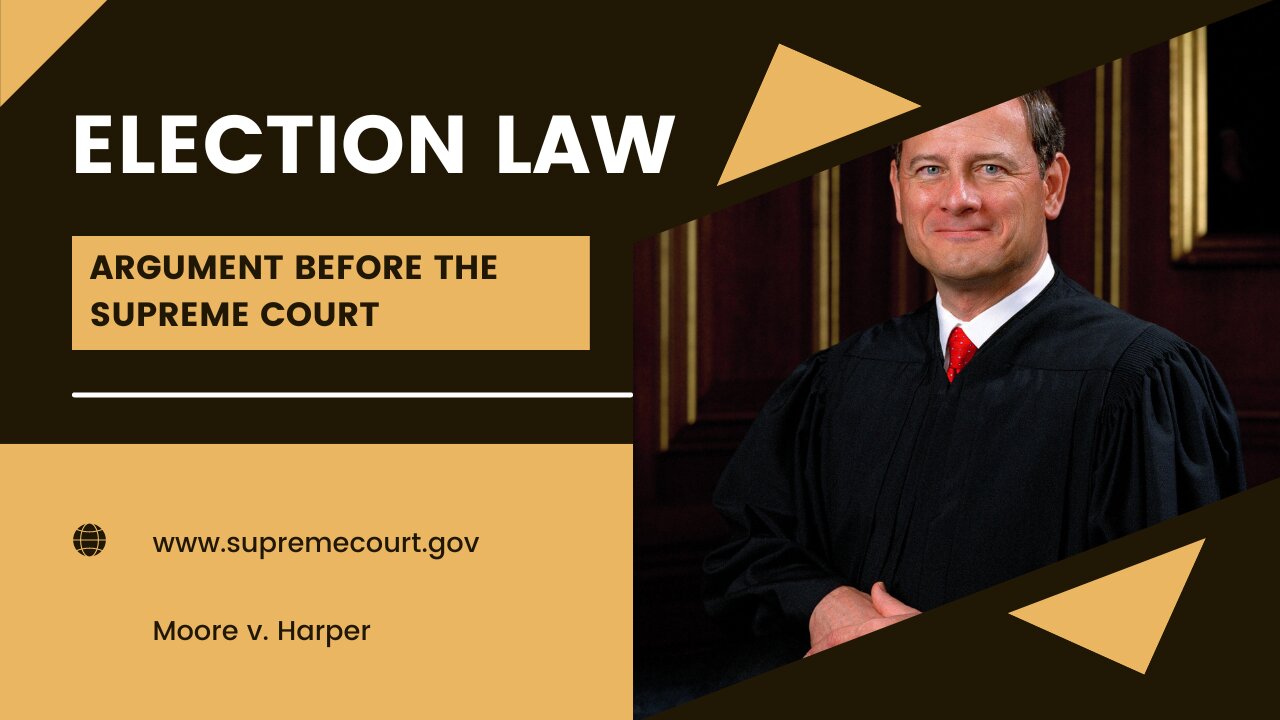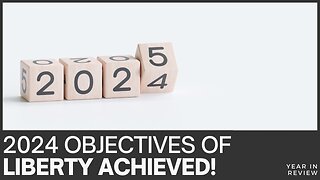Premium Only Content

Election case at argument
Election case at argument
By Terry A. Hurlbut
Moore versus Harper comes to argument! Good afternoon, ladies and gentlemen. This is another Declaration of Truth from your host, Terry Aay Hurlbut. Election law, as applicable to elections of Representatives in Congress, came before the United States Supreme Court yesterday. The Court heard argument on this one case for almost three hours. Today I conclude that lawyers for the North Carolina House of Representatives did not prepare adequately to argue for the sweeping change in election law they sought. Which was to cut the courts of North Carolina out of the process of drawing Congressional district maps. Furthermore the only reason we are at this pass is a set of precedents that make a mockery of federalism. Counsel for petitioners could and should have challenged that entire framework. They did not, and for that reason I think they’re going to lose.
Before I tell you how and why, I do want to shout out to the prime sponsor of this channel, which is Conservative News and Views – link in the description. And be sure to check out the awesome CNAV store – scroll down near the bottom for that link. Lots of great merchandise there, especially this Tee shirt I have chosen for today. Which reads: FREEDOM ISN’T FREE. And it’s going to take a lot of remedial civics education for us to keep what freedom we still have.
One more thing: if you like what you’re about to hear, you can like this video. You can also click the Bell icon to get a notice every time I come out with a new one. In fact, do you see the new icon, the heart shape with the You-Ess dollar sign in it? That’s the Super Thanks icon. If you really want to keep these videos coming, click that, and leave me a tip—any currency will do, so long as it’s legal tender.
The case at issue is Moore v. Harper (Docket no. Twenty-one-dash-twelve-seventy-one). Reportage on the argument session comes from See Bee Ess News and Politico, with a “live blog” from Democracy Docket. In addition, readers can play the Em Pea Three recording of the session directly, or read the transcript. I’ve left links in the description to the docket page, the Em Pea Three, and the transcript.
The case is a petition for review of a decision by the North Carolina Supreme Court. After the Twenty Twenty Census, North Carolina’s Republican dominated legislature drew a map favorable to their party. Several plaintiffs, including Common Cause, challenged the map as an unlawful partisan gerrymander. The North Carolina Supreme Court, applying North Carolina law, agreed and has struck down the maps. So Representative Tim Moore, Republican from Cleveland and Rutherford Counties), who, more to the point, is Speaker of the North Carolina House, petitioned the Supreme Court for review. In fact, yesterday afternoon Moore tweeted his reasoning for asking for the review. I have a link to the tweet in the description and will now quote the text: “This case is about one thing: who decides the inherently political question of how a state’s congressional districts should be drawn—the People’s elected representatives in the legislature or activist judges?” Unquote Tim Moore. The “activist judges” accusation comes from the definitely “woke” politics the North Carolina Supreme Court has shown thus far. In fact, furious North Carolina voters flipped the court when two Democrats failed of re-election last Midterms. One of them was Justice Samuel Jay Ervin the Fourth. Yes, he’s one of THOSE Ervins; his grandfather was the witty Chairman of the Senate Watergate Committee. Maybe most of you don’t remember, but I do – I remember sitting in front of an old cathode-ray color teevee set, listening to one of the Cuban exile witnesses before the committee; he had taken part in the burglary of the Watergate Hotel. So Senator Ervin asks, and I quote: “How did you expect to liberate Cuba by perpetrating a burglary in Washington, Dee See!?” I mean, he brought the HOUSE DOWN!
Anyway, his grandson just got thrown off the bench, together with another Democrat Justice. The thing is, it’s too late to get a reversal on the case at hand at North Carolina Court level. So that won’t help the Republicans press their advantage in redistricting. Tim Moore filed this petition as a Hail Mary pass.
He filed his petition invoking the INDEPENDENT STATE LEGISLATURE THEORY. According to it, the Constitution vests in State legislatures ONLY the power to draw Congressional districts. (This also includes the power to set laws qualifying voters for Representatives and Senators.) You remember I discussed this before, last July. Briefly, the Constitution (Article One, Section Four, Clause One) says the “legislatures” will prescribe “the time, place and manner of holding elections for Senators and Representatives.” LEGISLATURES, it says – and NOT the courts.
The Constitution said nothing about a legislature “prescribing by law.” But the Supreme Court held in Nineteen Thirty-two that redistricting is a lawmaking function. Therefore, at minimum, State governors have their usual veto powers, as on other bills. (Smiley v. Holm, Two Eighty-five You-Ess Three Fifty-five, (Nineteen Thirty-two)). I have a link to that case in the description. That holding speaks directly to what a legislature is, and what powers a governor has over the legislative process. It does NOT, however, explicitly provide for STATE JUDICIAL REVIEW of a district map.
More recently the Supreme Court has held that whenever a State Constitution vests redistricting power in an “independent commission,” such commission is a “legislature” within the meaning of the You-Ess Constitution. Therefore the federal Constitution cannot override this. (Arizona State Legislature v. Arizona Independent Redistricting Commission, Twenty Fifteen).
This case concerns a legislature within the usual meaning. The governor did not veto the original maps, so Tim Moore decided not to make an issue of veto power. But as a further complication, SCOTUS has already said it will never again hear a partisan gerrymander case. (Rucho v. Common Cause, Twenty Nineteen.)
Right about now I hear some of you asking: how do you measure partisan gerrymandering? I’m going to take a little extra time to explain that, because it illustrates the silliness of where we are, and the pressing need to find another way to solve the problem of districts coming out looking like somebody’s pocket comb, or the letter Wye, or this, that, and the other. Before I begin, I want to shout out to a sponsor who can REALLY HELP YOU through the economic storms to come. That sponsor is Our Silver Lines Dot Com. Do you feel like you’re working harder for your money, just to get by? You are NOT alone. The fluctuating economy, employment issues, and unexpected changes in life have left many families struggling over the past few years. Collecting gold and silver can help shield you against many of these challenges. But if you’re like me many years ago, you don’t know where – or how – to start.
Our Silver Lines helps by connecting you with thousands of members who are learning the secrets to creating AND PROTECTING true wealth – by collecting precious metals. Whether you just want to collect rare and unique coins… or take advantage of the business opportunities that company provides… they can help you learn to live an exceptional life. Visit Our Silver Lines Dot Com to learn how YOU can build a legacy for your future!
Now: in an article in University of Chicago Law Review, Nicholas Stephanopoulos and Eric McGhee proposed a measure they called the EFFICIENCY GAP to measure partisan gerrymandering. EFFICIENCY in this context means not only winning, but winning with as few votes as a Party needs. Typically this applies only to a two-Party election in a single-member district. The losing party LOSES all votes cast for it. Contrariwise, the WINNING party EXCEEDS necessary votes when it wins by more than fifty percent plus one. Any Party WASTES votes that they either LOSE or by which they EXCEED the Magic Number.
The EFFICIENCY GAP is the sum of differences (as ABSOLUTE VALUES) between lost votes (the loser) and excess votes (the winner) over all districts in a State, as a fraction of all votes cast. The ABSOLUTE VALUE of any number is that number with any minus sign stripped away. Thus the absolute value of, say, one, is one – and the absolute value of minus one is also one. It is one away from zero, so it doesn’t matter which number is to the left of the other on the number line. So the absolute value of the DIFFERENCE between two numbers is how far apart they are – without regard to which number is greater than the other before you subtract one from the other.
So to calculate the efficiency gap, first you determine the wasted votes for each party. So in each district, if the party lost, count every vote it got as wasted – and if it won, count every vote PAST FIFTY PERCENT PLUS ONE as wasted. Then you SUM ALL THOSE UP across all districts for each Party. Then you subtract the wasted votes by one Party from the wasted votes by the other – and again, make sure to subtract the lesser from the greater, because you want the ABSOLUTE VALUE. Then you divide by the total vote across all Districts, and multiply by a hundred percent. THAT is the efficiency gap. I have that from Ballotpedia, and I’ve left a link in the description to that, too.
The highest possible efficiency gap is fifty percent. The winner takes all seats by fifty percent plus one, and the loser wastes every vote cast for it. In theory one could achieve BALANCED efficiency, meaning winners exceed their necessary votes by THE SAME AMOUNT that losers waste. That requires winners to take their seats by an average of seventy-five percent. Winner wastes twenty-five percent of their votes over fifty percent plus one; loser wastes twenty-five percent; so they’re even. (And if a Party carries EVERY district with a hundred percent of the vote, the efficiency gap is also fifty percent.)
Do you see the problem in efficiency-gap thinking? THE ONLY WAY TO MINIMIZE THE EFFICIENCY GAP IS TO CREATE “SAFE DISTRICTS” EVERYWHERE. Furthermore, the ideal ratio of voters in any district is three to one for the winner. So the Parties might as well nominate only in their “safe” districts, and no districts will ever be competitive. Result: uncontested elections – and I count Empty Suits as no contest at all. And the districts will then take on even odder shapes than ever. As they did in order to carve out “safe minority districts” that followed Interstate Highways or railroad tracks.
If the legislature is going to do things that way, then THEY MIGHT AS WELL ELECT ALL REPRESENTATIVES AT-LARGE BY PROPORTIONAL REPRESENTATION, as they do in Israel. The State holds an election, and determines a total popular vote distribution between Parties. Then the Secretary of State awards MANDATES, or SLOTS, to each Party in proportion to that popular vote. Where, then, is the accountability that democratic elections are supposed to provide?
What they SHOULD do is make certain rules for legislative or Congressional redistricting. How about forbidding a District boundary to cross a county line, city or town limit, or city ward line? How about not splitting a county or independent city between or among two or more Districts, unless each District in the split is part OF that county or independent city? Ideally, each county or independent city should also get the same number of State Senators, one or two. But apparently the Supreme Court has said no to that, also.
“One person, one vote” is an unhealthy obsession. Tim Moore could and should have challenged THAT. Sadly, he did not.
Instead, Moore (or rather David Thompson, his attorney) tried to argue that although governors have a role, courts do not. In this he drew inspiration from Chief Justice William Rehnquist’s concurrence in Bush v. Gore (five thirty-one You-Ess ninety-eight comma one thirteen, Two Thousand). That case involved Presidential Electors, another question the Constitution gives to legislatures to answer. Rehnquist wrote (and Justices Antonin Scalia and Clarence Thomas agreed with him) that, and I quote: “A significant departure from the legislative scheme for appointing Presidential electors presents a federal constitutional question.” Unquote William Rehnquist.
As seems to be his pattern, Justice Thomas opened by asking Mr. Thompson to state clearly the Court’s jurisdiction in the case. Naturally Mr. Thompson cited the Elections Clause of the Constitution.
Soon afterward – and this did not change throughout the argument session – three blocs of Justices sorted themselves out. Justices Ketanji Brown Jackson, Elena Kagan, and Sonia Sotomayor were uniformly hostile to the petitioner and sympathetic to the Election case at argumentrespondents. (And to Solicitor General Elizabeth Prelugar, arguing as friend of the court.) Call them The Liberal Bloc. Justices Thomas, Samuel A. Alito, and Neil Gorsuch likewise proved sympathetic to the petitioners. Call them the Conservative Bloc.
The bloc of Chief Justice John Roberts and Justices Amy Coney Barrett and Brett Kavanaugh became the “Neutral Bloc.” All three members of it asked the hardest questions of petitioners and respondent side alike.
Tim Moore should have known over how high a bar he was trying to vault. As the Liberal and Neutral Blocs made abundantly clear, he is trying to override two hundred thirty-three years of history. The Independent State Legislature Theory finds some support in Bush v. Gore, but in a concurrence only, not the opinion of the Court. Of the three concurring Justices, only Clarence Thomas remains – though Alito and Gorsuch do seem to sympathize with him.
On the other hand, the two lawyers for the respondents – and the Solicitor General – seemed to be trying to present a case of res ipsa loquitur. (That’s Latin for “The thing speaks for itself.”) They also said that “chaos” would reign if the Court finds for Moore. The only practical result of this “chaos” they could allege is that State legislatures could draw districts however they wanted. What they really mean is that they (petitioners and the Solicitor General) would lose all the ground they have carefully gained toward their true goal: PROPORTIONAL REPRESENTATION, by color, race, creed, lifestyle, whatever.
The Justices seem to know this. Chief Justice Roberts trapped Thompson into expressing willingness to accept a rule limiting the efficiency gap to seven percent (Now you know why I took time to explain what an efficiency gap is.) But when he did that, Roberts exposed the most glaring weakness in the respondents’ case: NO FIRM RULES EXIST. The North Carolina Supreme Court simply made their determination and had no firm theory to back that up.
About halfway through my research into this case I found myself asking: how did we get here? The Supreme Court is hearing this momentous election case because Brett Kavanaugh looked at the prior election jurisprudence and quailed. “This is going to crop up again and again until we finally settle it!” he said in effect. “Enough! Let’s ‘grant cert’ in this or a similar case, set a precedent, and have done with this!” So we can guess which four Justices (at least) voted to grant review in Moore v. Harper: Thomas, Alito, Gorsuch, and Kavanaugh.
And when he briefed the Court, Moore’s lawyer made key mistakes. He could and should have seized upon the absence of the key phrase BY LAW in the Elections Clause and the Presidential Electors Clause. Justice Alito has already said, in Dobbs v. Jackson Women’s, that star-ray dee-sigh-sis is not a hard-and-fast principle anymore. So if cases like Smiley or Arizona needed re-litigating, then by all means re-litigate them! If Thomas Dobbs had made that mistake, he would not have achieved the result we all know. But the Mississippi Solicitor General boldly decided to re-litigate Roe v. Wade, and won the grand prize.
But many other precedents need re-litigating. All the litigation on gerrymandering have assumed that: one, political parties are legitimate, and two, proportional representation between and among them is only fair. Both are wrong, and both needed challenge. Look on Conservative News and Views and search on an author named Bradlee Dean; he’ll tell you that political parties have NO PLACE in the Constitution. This case is a missed opportunity. And though the Neutral Bloc asked equally hard questions of both sides, in the end they will find for the respondents. Most probably. Unless Clarence Thomas can go to work on them. Now that the case is officially submitted, he has half a year to make that happen.
Link in the description to the article, to docket, sound recording, and transcript for Moore versus Harper, to Tim Moore’s tweet from the Supreme Courthouse steps, to the cases of Smiley versus Holm, Arizona Legislature versus Arizona Commission, and Rucho versus Common Cause, to Ballotpedia’s explanation of the concept EFFICIENCY GAP, to my Declarations of Truth Twitter account, and to Conservative News and Views. I’ve also left links to the awesome CNAV store – and to Our Silver Lines Dot Com, as I also mentioned. You know already about how to like a video, turn on notifications, and leave a tip. On the end screen, I’m going to leave a subscribe link to my channel, and a link to an earlier video from July on this case. This is Terry A. Hurlbut delivering another Declaration of Truth, and reminding you – to let the truth set you free.
Link to:
The article:
https://cnav.news/2022/12/08/editorial/talk/election-case-at-argument/
Moore v. Harper:
Docket Listing:
https://www.supremecourt.gov/search.aspx?filename=/docket/docketfiles/html/public/21-1271.html
Sound recording:
https://www.supremecourt.gov/oral_arguments/audio/2022/21-1271
Transcript:
https://www.supremecourt.gov/oral_arguments/argument_transcripts/2022/21-1271_21o2.pdf
Speaker Moore’s reason to bring the case:
https://twitter.com/NCHouseSpeaker/status/1600598956941185047
Smiley v. Holm:
https://supreme.justia.com/cases/federal/us/285/355/
Arizona Legislature v. Arizona Redistricting Commission:
https://www.democracydocket.com/cases/arizona-independent-redistricting-commission-challenge/
Rucho v. Common Cause:
https://www.democracydocket.com/cases/north-carolina-partisan-gerrymandering-scotus/
Efficiency gap definition and hypothetical example, from Ballotpedia:
https://ballotpedia.org/Efficiency_gap
Declarations of Truth Twitter feed:
https://twitter.com/DecTruth
Conservative News and Views:
https://cnav.news/
The CNAV Store:
https://cnav.store/
Our Silver Lines
https://oursilverlines.com/
-
 15:16
15:16
Declarations of Truth
14 days ago2024 – objectives for liberty attained
181 -
 2:51:47
2:51:47
Price of Reason
15 hours agoJimmy Kimmel ATTACKS Trump and PROTECTS Gavin Newsom! Skeleton Crew Finale REVIEW! Ubisoft DEI Woes!
28.9K19 -
 5:14:42
5:14:42
JdaDelete
1 day ago $22.39 earnedThe Legend of Zelda: Skyward Sword HD | With SirPoopsMagee | Part 4
92K13 -
 4:56:18
4:56:18
Sgt Wilky Plays
12 hours agoTesting New setup and Chillin
80.3K5 -
 53:37
53:37
barstoolsports
18 hours agoOne Text Changes The Game | Surviving Barstool S4 Ep13
94.3K7 -
 3:14:48
3:14:48
Laura Loomer
11 hours agoEP93: Senate Grills Trump Admin Nominees As Inauguration Approaches
50.8K32 -
 1:29:23
1:29:23
Kim Iversen
13 hours agoTrump TURNS On Netanyahu! Forces Israel To END THE WAR And Stop The Bloodshed
73.9K254 -
 1:50:24
1:50:24
Danny Polishchuk
15 hours agoThe Funniest Call In Show On Earth - Live From New York City's Best Comedy Club
92.2K9 -
 1:03:22
1:03:22
Man in America
18 hours ago🚨 RED ALERT! SmartLA 2028, C40 Cities, CA Fires & the UN 2030 Blueprint
92.5K46 -
 59:39
59:39
Flyover Conservatives
1 day agoLeft for Dead: The Dark Secrets Behind Clinical Trials Exposed - Brianne Dressen, React19 | FOC Show
65.9K1